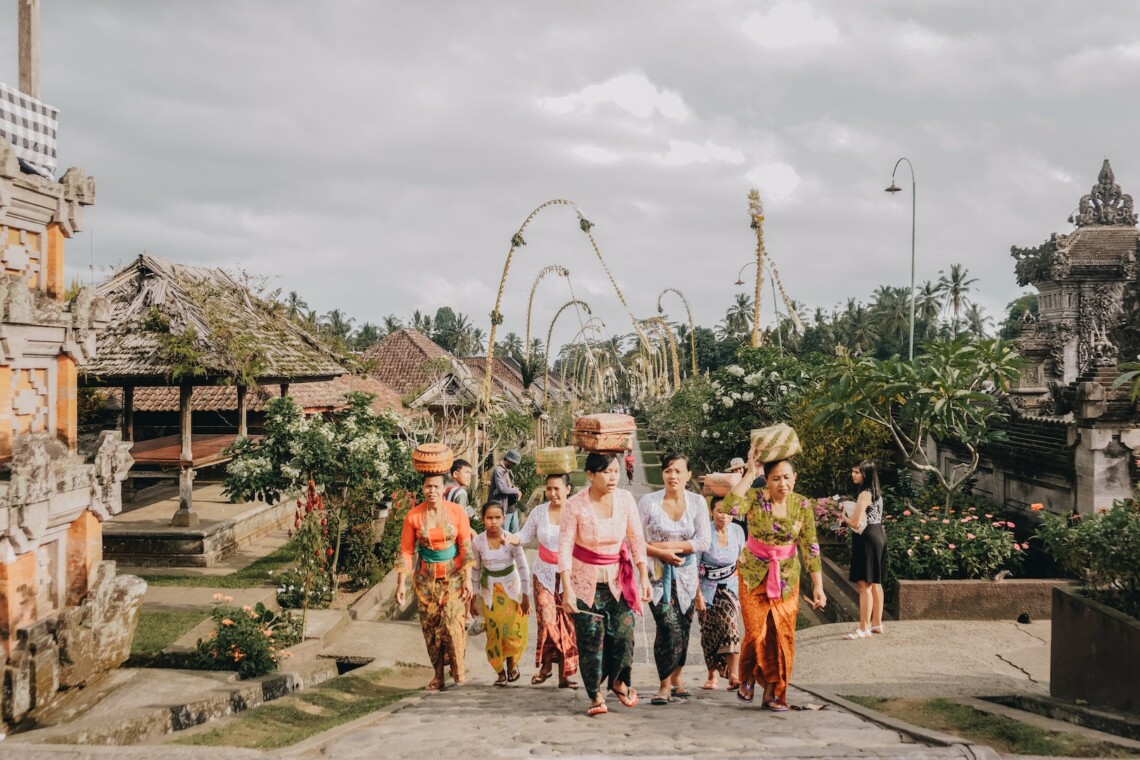Best Art Market in Bali That’s Worth a Visit!
- 17/01/2024
- Articles
Illustration of Best Art Market in Bali, photo by Charlie Pauly The Island of Gods is home to a truly fascinating culture... Read More

Illustration of Galungan, photo by Ruben Hutabarat on Unsplash
Step into the heart of Balinese spirituality with our guide to Galungan, one of Bali’s revered religious festivals. In this exploration of culture and faith, we unveil the essence of Galungan, a celebration that beautifully intertwines religious traditions with the vibrant spirit of Bali. Join us on a journey through the festivities that define this significant occasion, and discover the cultural richness that makes Galungan a cherished and captivating experience on the island of Bali!
Illustration of Balinese Ceremony, photo by Wisnu Widjojo on Unsplash
The island is decked out in glitzy religious ornaments, so you’ll know when Galungan is approaching a few days, if not weeks, before it arrives. The penjor, or bamboo poles decorated with offerings constructed on the side of the street in front of homes and shops, are particularly famous.
Galungan is the day when spirits, particularly ancestors and deities, descend from heaven and visit Earth. It may appear to some to be similar to Mexico’s Dia de los Muertos, or Day of the Dead. Still, conceptually it is more similar to India’s Diwali, as both celebrate the triumph of dharma (good) over adharma (evil).
Illustration of Balinese Offerings, photo by Artem Belaikin on Unsplash
There is a myth or legend associated with it, like with other good Balinese ceremonies. In truth, two stories are related to Galungan, but I’ll give the most widely recognized. During the reign of the Majapahit empire, a primarily Hindu country, there was a powerful and terrifying man known as Mayadenawa – the son of a malicious monarch with unlimited power.
Even the huge Majapahit army was thought to be powerless against him. Mayadenawa inflicted devastation on Hindus by burning temples and denying devotion. The Hindus prayed to the gods, and the God Indra responded.
Lord Indra descended from the sky and launched a massive assault on the cruel – and godless – Mayadenawa. Indra and his army fought the heinous villain battle after battle, but God always won.
Their victory occurred on the Wednesday of the 11th week of the Balinese Pawukon calendar, now known as Galungan Day, which is honored every 210 days. Wednesday of the Pawukon calendar’s 11th week. This event recalls Indra’s (dharma, or good) triumph against King Mayadenawa (adharma, or evil). Indra’s descent to Earth was also symbolic of the arrival of other spirits on the same day.
This fable of Indra vs Mayadenawa is also the genesis story of the Tampaksiring region. Mayadenawa was reported to have slipped into Indra’s men’s barracks and poisoned the well during their conflict. He crept out by walking on the sides of the fit, leaving tracks in the mountainside. This is how the neighborhood got its name: Tampak means “food,” and siring means “slanted.”
Tirtha Empul, the famous holy water temple, is also found in Tampaksiring, and tradition has it that Indra created the spring to restore his army after the wicked demon poisoned them.
On the eve of Galungan, Penampahan Galungan, animals are sacrificed as special offerings to cleanse the Bhuana Agung (the macrocosm, the world around us) and the Bhuana Alit (the microcosm, the world within us); the meat is then prepared and cooked for traditional Balinese dishes such as lawar, babi guling, and satay. The Balinese, particularly the children, look forward to Penampahan Galungan because it is a typical family party day with a variety of delectable dishes.
On the day of Penampahan Galungan, it is also believed that the Sang Kala Tiga in the form of Sang Bhuta Amangkurat descends to earth for the third and final time to tempt mankind to Adharma (evil).
Every temple, shrine, and street corner will be packed with worshippers on Galungan Day, making it an incredible cultural spectacle to witness. The atmosphere is alive: even before the sun rises, whiffs of incense carry the scent of devotion. On this particular day, everyone dresses up in their best Balinese attire to pray.
Illustration of Kuningan Festivals, photo by Aditya Nara on Unsplash
People will visit their families the day after Galungan, Manisan Galungan, and then 10 days later will be the end of the Galungan ‘season’ called Kuningan, when the spirits will return to the land ‘up there,’ Tanah ane wayah.
Returning to the legend of Galungan (as told in the Galungan story), after King Mayadenawa was defeated in battle, the victorious Balinese and Majapahit troops were concerned that the cunning ruler had simply used magic to disguise himself as a statue, a tree, or an animal. So they waited ten days to be certain.
Their victory over Mayadenawa was officially announced to the people on the 10th day, which became known as Kuningan Day. The word is said to have two meanings: ‘to announce’ – as in the legend – and yellow, which is the predominant color in Kuningan worship and celebrations.
If you want to visit Bali and experience the beauty of Galungan and Kuningan, you can contact us at info@asiaholidayvilla.com and message us at (+62) 816-342-767. We will make you experience Balinese festivals to the fullest!
Join The Discussion